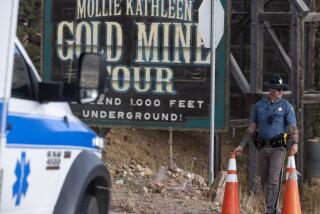Black Mineworkers Union Assails S. Africaâs Safety Standards; Fire Toll Up to 177
JOHANNESBURG, South Africa â The all-black National Union of Mineworkers on Wednesday denounced the âunacceptably low safety standardsâ of South Africaâs mining industry after the deaths of 177 miners in the countryâs worst mine disaster since 1960.
âThis disaster is a clear indictment of the industry and makes clear that its claims of having the lowest fatality and injury rate in the world are absurd,â the 250,000-member union said in a statement.
It called for a full government investigation into mine safety after Tuesdayâs fire at the Kinross Gold Mine and added: âIt has required tragedy after tragedy and the loss of many lives for the industry and government to pay attention to safety standards.â
Seven miners were still missing and presumed dead in tunnels a mile underground at Kinross, a medium-size but rich gold mine 65 miles east-southeast of Johannesburg; 235 others were hospitalized, many in serious condition.
To the National Union of Mineworkers and other black unions, the issue is the extent to which white-owned companies sacrifice black workers, whether through low pay, unsafe working conditions or forced increases in output, in order to increase production and profits.
âAre the mine bosses too busy pursuing profits to care about the lives and safety of black miners?â the Congress of South African Trade Unions, the countryâs largest federation of labor unions, asked in a separate statement.
It noted that all but five of the dead miners were blacks, most of them migrant workers from neighboring countries, and said that âthe continuing tragedy of the mining industry is that black miners are paying with their lives for the wealth and profits they do not share.â
Danie Steyn, the minister of mining and energy affairs, said on visiting the mine that government engineers will begin an immediate investigation. âIt was one of the very great disasters in our industry,â Steyn said, âand a very, very great shock to all of us.â
The five white victims of the disaster and their families were featured on South African television and radio and in the newspapers here; the 172 black victims were described in terms of the countries from which they came, such as Lesotho or Mozambique, or the tribal groups to which they belonged, such as Zulus or Xhosas, but without further information.
Two of the whites, a shift boss and a surveyor, died in heroic attempts to rescue the trapped miners, most of whom were blacks.
Mindful of the political implications of the accident, state-run Radio South Africa said early this morning in a commentary reflecting government views that such incidents ârarely occurâ here and that the countryâs mines are the worldâs safest.
But an average of 600 miners die every year in the mines, and the International Labor Organization, in a highly critical study of South Africaâs mine safety standards, reported recently that accident deaths totaled more than 8,500 between 1973 and 1984.
At Kinross, all the casualties were apparently caused by smoke inhalation rather than the underground fire itself. When the special sealant used on the damp mine walls began to burn, along with polyvinyl chloride pipes and plastic-coated wires, toxic fumes were produced that contained large amounts of cyanide and chlorine gases as well as carbon monoxide and carbon dioxide.
Use of the polyurethane sealant on the mineâs walls to control water seepage and corrosion seems likely to be the initial focus of the safety controversy, but larger issues are already being raised. Kobus Olivier, the Kinross general manager, told a press conference at the mine Wednesday that neither he nor his assistants were aware that the sealant was flammable and highly toxic when burned, although it had been used at the mine for six years.
Work crews were covering tunnel walls with the sealant Tuesday morning, according to mine officials, when a spark from a welding torch set fire to cylinders of oxygen and acetylene gas. The fire spread quickly to the mine walls and then to plastic-covered wires and pipes running through the mine tunnels.
Survivors said the mine quickly filled with dense smoke that made it not only difficult to breathe but, in the words of one miner, âseemed to fell men like so many trees--the smoke would hit them and they would fall on the spot.â
âNo one would have died if it werenât for the toxic substances,â Olivier said. âNo one died in the fire itself, no one was burned to death.â
Rescue teams using special breathing apparatus brought out more than 2,200 miners in a dramatic daylong operation, and they continued the search on Wednesday for the men still missing.
Olivier acknowledged under questioning that Kinross had lost its top, five-star international safety rating last year and was downgraded to three stars. Of South Africaâs 100 major mines, 82 take part in the rating system, and 25 have five-star ratings.
For a major mine like Kinross, which has 8,000 employees, a three-star rating implies serious safety problems.
Cyril Ramaphosa, general secretary of the National Union of Mineworkers, said after a three-hour visit to Kinross and discussions with local union officials and members that safety would be placed even higher on the agenda in current negotiations with mine owners.
âThis is a terrible disaster, and I donât know whether we should proceed with negotiations,â Ramaphosa said. âOur members in virtually all the mines are aggrieved and very angry.â
After talking with survivors, including a number of the hospitalized, Ramaphosa said the tragedy probably could have been avoided had the welding crew, which was repairing a broken rail for the underground railway, been equipped with the fire extinguishers required under normal safety procedures.
Kinross is owned by the General Union Mining Corp., known as Gencor, which prides itself on its toughness in dealing with labor unions. Company officials said repeatedly Wednesday that mine safety is âa management matter . . . and not an issue for discussion with the NUM (the union).â
Gencor, which the union has branded an âenemy companyâ because of its alleged âanti-labor outlook,â also owned the coal mine where 437 miners were killed in 1960, when a tunnel collapsed on them, and a second coal mine where 68 miners died in 1983 after a methane gas explosion.
Although the South African Chamber of Mines reported only this week that the number of deaths per thousand miners has dropped to 0.88, reflecting a 40% decline over the last decade, the National Union of Mineworkers has made safety a priority in all its negotiations.
Jean Leger, a researcher at the University of the Witwatersrand in Johannesburg and the unionâs adviser on safety, argued in a study last year that the minesâ system of production bonuses, rewarding white supervisors more than black miners, had inherent safety problems because a white miner âwields arbitrary power, is not held responsible for accidents and does not share the same hazards as the black miner.â
More to Read
Sign up for Essential California
The most important California stories and recommendations in your inbox every morning.
You may occasionally receive promotional content from the Los Angeles Times.










